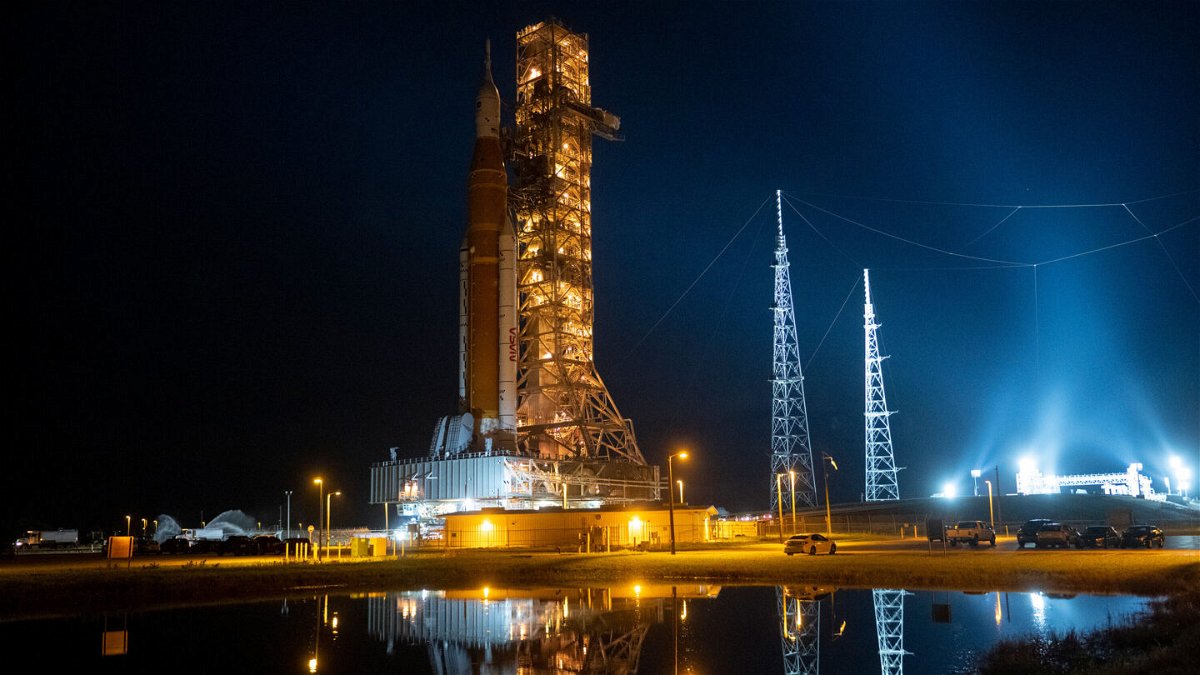Artemis I rocket rolled back inside as Hurricane Ian treks toward Florida

NASA has rolled the massive Artemis I mega moon rocket back into its hangar
By Kristin Fisher, Jackie Wattles and Ashley Strickland, CNN
NASA has rolled the massive Artemis I mega moon rocket back into its hangar, called the Vehicle Assembly Building, at Kennedy Space Center in Florida to protect it from Hurricane Ian.
The hurricane made landfall in western Cuba early Tuesday. The Category 3 storm is tracking toward Florida.
The move, which concluded at 9:15 a.m. ET Tuesday, delays the third launch attempt for the Artemis I mission, which is slated to send an uncrewed capsule around the moon, for at least a few weeks.
The setback would likely push NASA’s next try into November, though late October potentially could still be an option for the highly anticipated launch.
“We know that the earliest it could go is late October, but more than likely we’ll go in the window in the middle of November,” NASA Administrator Bill Nelson told CNN.
“Managers decided to roll back based on the latest weather predictions associated with Hurricane Ian not showing improving expected conditions for the Kennedy area. The decision allows time for employees to address the needs of their families and protect the integrated rocket and spacecraft system,” NASA noted on its Artemis blog.
The rocket, called Space Launch System or SLS, made the 4-mile (6.4-kilometer) slow trek back to the maintenance building starting at 11:21 p.m. ET on Monday.
Tuesday morning, the Vehicle Assembly Building, the towering structure housing the rocket, was evacuated, according to NASA.
“At approximately 11:45pm today, a fire was reported in the Vehicle Assembly Building. Employees were evacuated, and there are no reported injuries. The VAB is fire safe, and the Artemis I vehicle was not at risk,” according to a tweet from Kennedy Space Center.
The fire occurred at a 40 volt electrical panel on a south side wall of High Bay Three, according to Janet Petro, director of the Kennedy Space Center.
They don’t yet know whether it was a breaker or an electrical short that caused the incident. Only a handful of people were inside at the time.
“It was a good distance from the actual vehicle itself,” Petro said in a news conference. “We’ll be doing an investigation and will provide updates as we have them.”
The NASA team at Kennedy has been securing facilities and equipment and preparations are underway to prevent any objects from coming loose and becoming projectiles. HURCON, or Hurricane Condition, is a scale used by the US Armed Forces to indicate the state of emergency as a hurricane approaches. The center is currently at HURCON 3, which is declared when damaging winds are possible within 48 hours. Petro expects that on Wednesday the center will be at HURCON 2, the level indicating damaging winds are possible within 24 hours.
A team will report to the center to ride out the storm, while non-essential personnel will leave.
“After the storm has passed, teams will conduct inspections to determine impacts at the center and establish a forward plan for the next launch attempt, including replacing the core stage flight termination system batteries and retesting the system to ensure it can terminate the flight if necessary for public safety in the event of an emergency during launch,” according to an update in the Artemis blog.
There are 20 limited life items that the Artemis team will assess while the rocket stack is in the maintenance building, said Jim Free, associate administrator for NASA’s Exploration Systems Development Mission Directorate.
The overall goal of NASA’s Artemis program is to return humans to the moon for the first time in half a century. And the Artemis I mission — which is expected to be the first of many — will lay the initial groundwork, testing the rocket and spacecraft and all its subsystems to ensure it’s safe enough for astronauts to fly.
But getting this first mission off the ground has proven to be a trying endeavor. The agency had already decided over the weekend to postpone the third launch attempt, which was previously scheduled for Tuesday, September 27, due to weather concerns. The question going into Monday morning was whether the mission team would need to roll the rocket back to shelter as Hurricane Ian headed toward Florida.
With that decision made, NASA focused on getting the roughly $4 billion SLS rocket back to the nearby Vehicle Assembly Building, a massive structure large enough to house the vehicle as it sits upright. The rocket made the trip by slow crawl, riding atop a moving platform named the Crawler-Transporter 2.
Technical issues thwarted the first two attempts to get the SLS rocket off the ground for the Artemis I mission. A main challenge was a series of leaks that sprung up as teams attempted to fill the rocket with super-chilled liquid hydrogen fuel. The mission team worked to troubleshoot those issues and ran a test last week. Though the tests didn’t go exactly according to plan, NASA deemed it a success, saying it “accomplished all our primary objectives.”
The-CNN-Wire
™ & © 2022 Cable News Network, Inc., a Warner Bros. Discovery Company. All rights reserved.